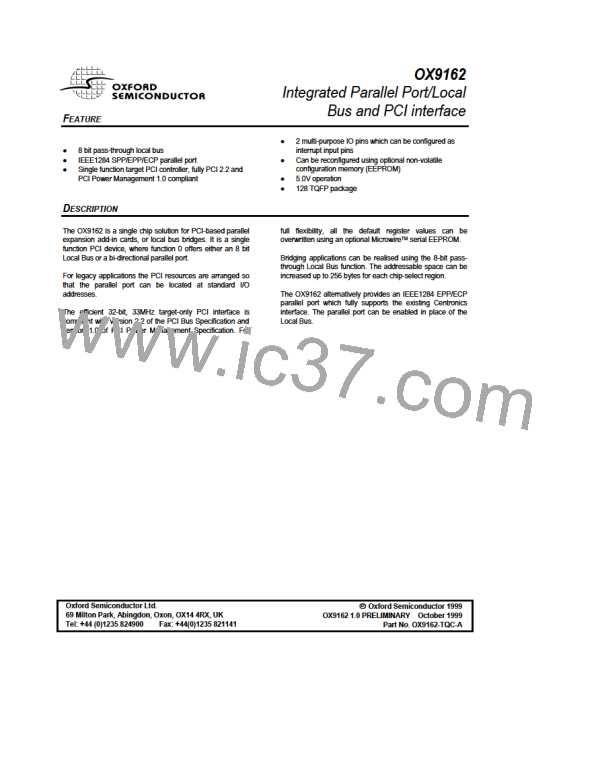OX9162
OXFORD SEMICONDUCTOR LTD.
PCI TARGET CONTROLLER
4
The OX9162 will complete all transactions as disconnect-
with-data, i.e. the device will assert the STOP# signal
alongside TRDY#, to ensure that the Bus Master does not
continue with a burst access. The exception to this is Retry,
which will be signalled in response to any access while the
OX9162 is reading from the serial EEPROM.
4.1 Operation
The OX9162 responds to the following PCI transactions:-
·
Configuration access: The OX9162 responds to type 0
configuration reads and writes if the IDSEL signal is
asserted and the bus address is selecting the
configuration registers for function 0. The device will
respond to the configuration transaction by asserting
DEVSEL#. Data transfer then follows. Any other
configuration transaction will be ignored by the
OX9162.
The OX9162 performs medium-speed address decoding as
defined by the PCI specification. It asserts the DEVSEL#
bus signal two clocks after FRAME# is first sampled low on
all bus transaction frames which address the chip. Fast
back-to-back transactions are supported by the OX9162 as
a target, so a bus master can perform faster sequences of
write transactions to the parallel port or local bus when an
inter-frame turn-around cycle is not required.
·
IO reads/writes: The address is compared with the
addresses reserved in the I/O Base Address Registers
(BARs). If the address falls within one of the assigned
ranges, the device will respond to the IO transaction
by asserting DEVSEL#. Data transfer follows this
address phase. For all modes, only byte accesses are
possible to the function BARs (excluding the local
configuration registers for which WORD, DWORD
access is supported). For IO accesses to these
regions, the controller compares AD[1:0] with the byte-
enable signals as defined in the PCI specification. The
access is always completed; however if the correct BE
signal is not present the transaction will have no
effect.
The device supports any combination of byte-enables to
the PCI Configuration Registers and the Local
Configuration registers (see Base Address 2 and 3). If a
byte-enable is not asserted, that byte is unaffected by a
write operation and undefined data is returned upon a read.
The OX9162 performs parity generation and checking on
all PCI bus transactions as defined by the standard. If a
parity error occurs during the PCI bus address phase, the
device will report the error in the standard way by asserting
the SERR# bus signal. However if that address/command
combination is decoded as a valid access, it will still
complete the transaction as though the parity check was
correct.
·
Memory reads/writes: These are treated in the same
way as I/O transactions, except that the memory
ranges are used. Memory access to single-byte
regions is always expanded to DWORDs in the
OX9162. In other words, OX9162 reserves a DWORD
per byte in single-byte regions. The device allows the
user to define the active byte lane using LCC[4:3] so
that in Big-Endian systems the hardware can swap the
byte lane automatically. For Memory mapped access
in single-byte regions, the OX9162 compares the
asserted byte-enable with the selected byte-lane in
LCC[4:3] and completes the operation if a match
occurs, otherwise the access will complete normally
on the PCI bus, but it will have no effect on either the
parallel port or the local bus controller.
The OX9162 does not support any kind of caching or data
buffering, other than that in the parallel port. In general,
registers on the local bus can not be pre-fetched because
there may be side-effects on read.
4.2 Configuration space
The OX9162 is
a single function device, with one
configuration space. All required fields in the standard
header are implemented, plus the Power Management
Extended Capability register set. The format of the
configuration space is shown in Table 2 overleaf.
In general, writes to any registers that are not implemented
are ignored, and all reads from unimplemented registers
return 0.
·
All other cycles (64-bit, special cycles, reserved
encoding etc.) are ignored.
Data Sheet Revision 1.1 PRELIMINARY
Page 9

 OXFORD [ OXFORD SEMICONDUCTOR ]
OXFORD [ OXFORD SEMICONDUCTOR ]